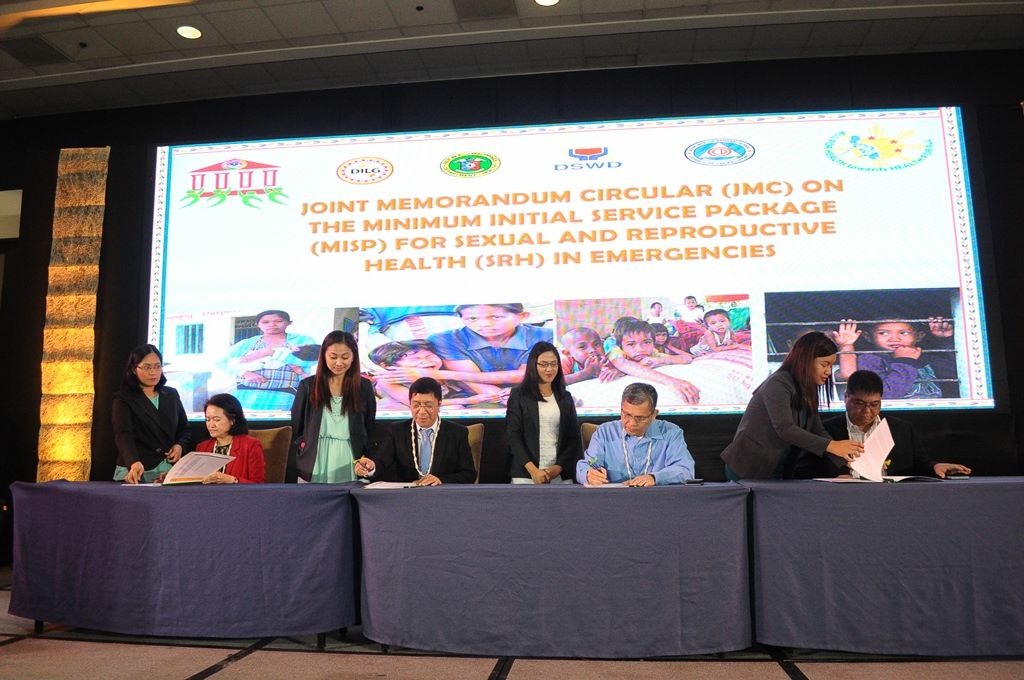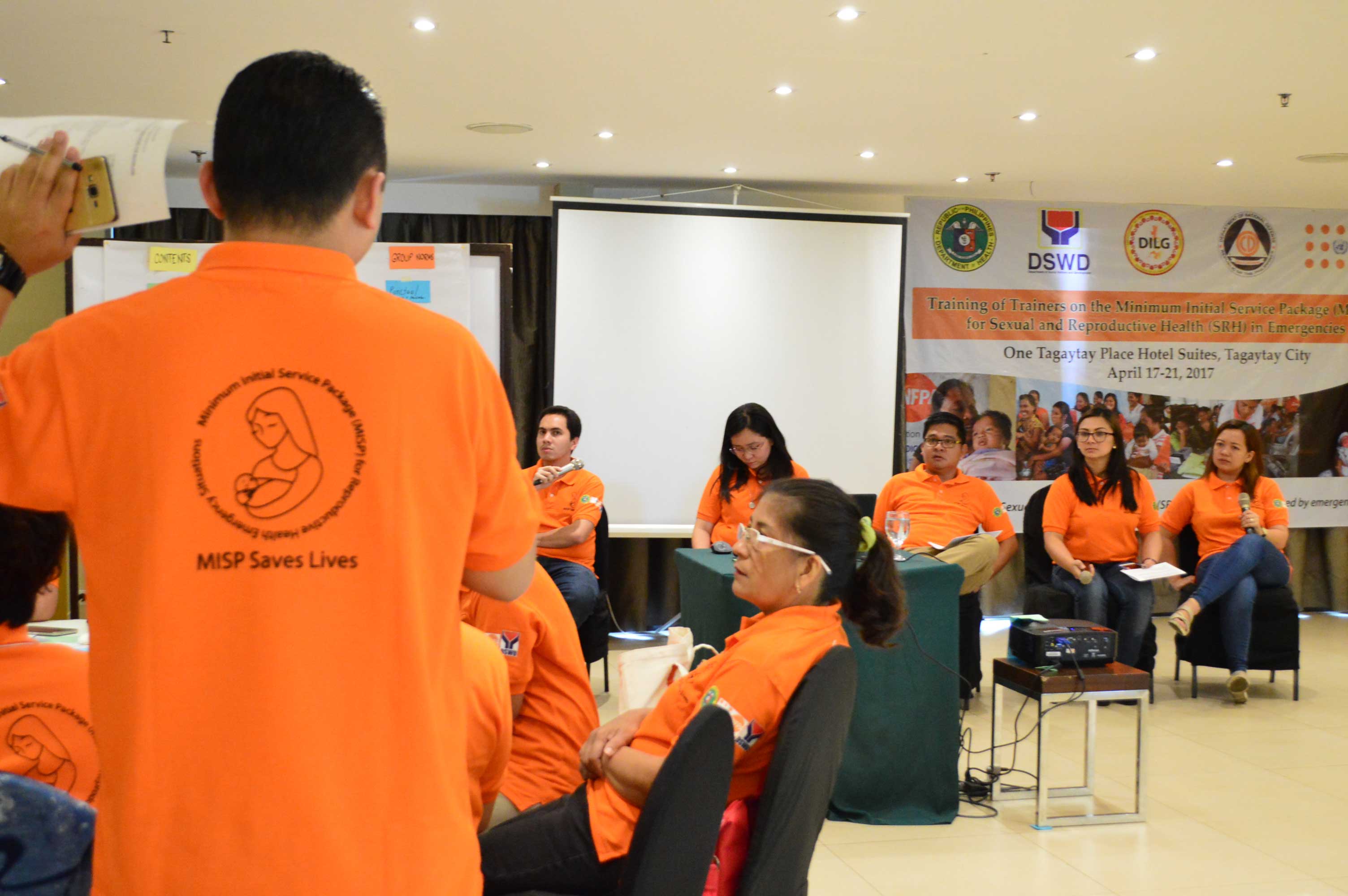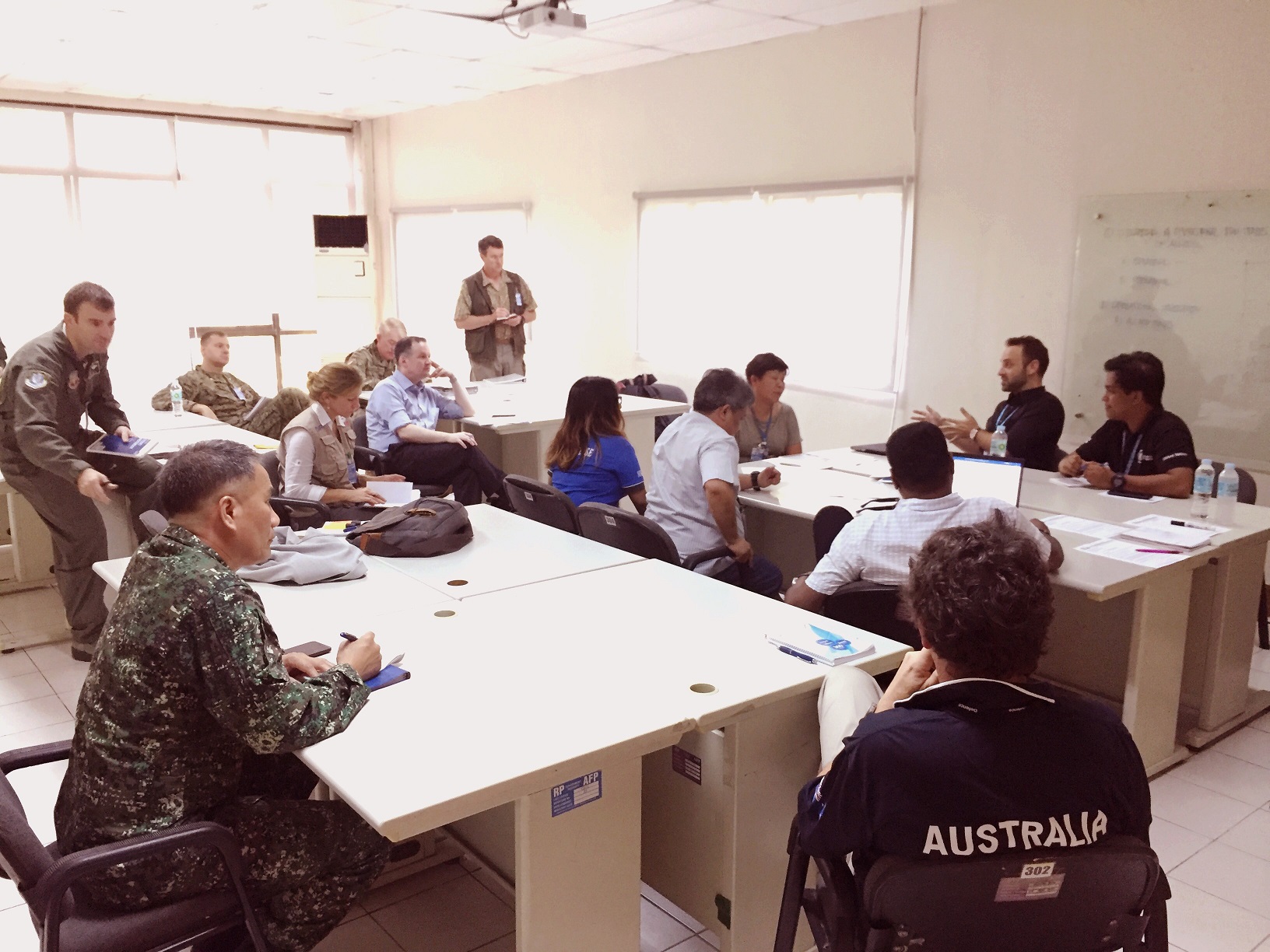
Over 100,000 displaced in Marawi as conflict continues and martial law in effect in Mindanao
Armed conflict continues in Marawi City, Autonomous Region of Muslim Mindanao (ARMM), where as of 31 May, more than 100,000 people have been forced to flee their homes to seek safety in nearby provinces. According to the Department of Social Welfare and Development (DSWD), out of the displaced, more than 13,000 are in evacuation centres while over 79,000 are staying with family and loved ones. The firefight started on 23 May between the Government army and the Maute Group, a local non-state armed organization. Two weeks into the clash, media are reporting that fatalities are close to 100, including 19 civilians. Airstrikes by Government forces continue to target remnants of the Maute Group who have occupied a number of buildings in the city.

Credit: DSWD Marawi City, ARMM (29 May 2017) - Regional and provincial welfare authorities distribute family food packs to a remote barangay.
Government response and relief assistance
On the evening of 23 May, the national government signed Proclamation no. 216, declaring a state of martial law and suspending the privilege of the writ of habeas corpus for the entire island of Mindanao. Human rights groups and local Mindanao political leaders have appealed to the government to uphold rights of civilians during this period.
The ARMM government is continuing to evacuate people trapped in Marawi City, and has delivered relief items such as food and water within the city. Local authorities also continue to provide relief items and health services to those who have fled the fighting. The ARMM government reports an estimated 2,300 people caught in the conflict zone as of 29 May.
National and regional authorities set up the Regional Coordination Center in Iligan City on 29 May. Chaired by the Office of Civil Defense (OCD) Region X, OCD ARMM, and the ARMM Regional Disaster Risk Reduction and Management Office, it is serving as the main sub-national coordination hub until further notice.
In Manila, the Departments of Health and Education have called respective cluster meetings on 31 May and 1 June and invited the Humanitarian Country Team, composed of UN agencies and international non-governmental organizations. The Department of Foreign Affairs also held a briefing to the diplomatic community on the overall situation in Mindanao.
Humanitarian coordination and response
As the situation continues to evolve, protection is an increasing concern, especially in evacuation centres. According to UNHCR’s protection update, as of 30 May, access to food and other basic items such as drinking water and medicine remain a priority need for those who are in evacuation centres as well as those staying with their families. Initial protection concerns have been identified in evacuation centres, such as shelter from heat and rain, insufficient latrines, water and sanitation facilities which could trigger health risks.
On 29 May, the ARMM government made a request for assistance to the Mindanao Humanitarian Team, which consists of UN agencies and international and local non-governmental agencies. The request was to support water and sanitation needs at evacuation centres and host municipalities. There was also an expressed need for assistance to help track IDPs.
The International Committee of the Red Cross (ICRC) and the Philippine Red Cross have had teams operating between in and between Iligan and Marawi Cities since 26 May. They are supporting evacuation centres in Marawi City and Saguiaran and are transporting people from Marawi City to the centres and other places outside the city. The Red Cross is also augmenting the Government’s response activities, including the provision of several water treatment plants and water bladders. Other assistance includes delivering medical supplies to hospitals, and providing psycho-social support to evacuees.

Credit: Philippine Red Cross ARMM (28 May 2017) - Philippine Red Cross volunteers provide roadside assistance to those fleeing for Iligan City and Cagayan de Oro with water, meals and first aid.
ACTED, IOM, OCHA, UNFPA, UNICEF, UNHCR, WFP and Community and Family Services International are in Iligan City coordinating with the Regional Coordination Center. UNHCR has a team on the ground and have distributed tarpaulins to one municipality and to ARMM-HEART for shelter use. OCHA has deployed a team to Iligan City to support coordination and information management with the Government’s Regional Coordination Center. Limited movement outside of Iligan City makes it a challenge to monitor the situation, and affects the humanitarian response. Presently, members of the Humanitarian Country Team are responding to requests for assistance using prepositioned stocks and other resources available in the country.
Access to food and other basic items such as drinking water and medicine remain a priority need for those who are in evacuation centres as well as those staying with their families.
Sabah deportees and their plight
The search for a better livelihood has forced many Filipinos to travel from southern Mindanao to Sabah, Malaysia. The Department of Social Welfare and Development (DSWD) estimates there are 7,000 undocumented Filipinos living and working in Sabah who are expected to be deported to the Philippines by Malaysian Authorities. Every week, many are arriving from Sabah by boat in Zamboanga City and Tawi-Tawi reception centres established by the Government.

A Mindanao youth's journey to Sabah
Fernando (not his real name) is a 17-year old Badjao teen who reached the third grade before abandoning school to work in Sabah to help his family. His mother and five siblings are among those displaced by the Zamboanga conflict in 2013 between Government forces and the non-state armed armed group Moro National Liberation Front (MNLF). The armed conflict displaced 120,000 people and burned a Badjao village to the ground. After living temporarily in transitory sites in Mampang, they moved to a permanent shelter in Valle Vista in Kasanyangan, Zamboanga City. Livelihood became a major challenge in the permanent shelters which lack clean water supply, sanitation and electricity. An estimated 6,900 displaced people continue to live in transitory shelters and await allocation of permanent shelters in Zamboanga City.
When Fernando reached Sabah, he found employment at a factory, earning 3,000 pesos (US$60) a month. He sent money to his family through relatives or friends traveling back to Zamboanga. It was difficult to continue working in Sabah without documentation due to occasional police crackdowns.
In January 2017, he decided to return home to find proper documents that will allow him to stay in Malaysia as immigrant worker. However, since returning he has not been able to find a job in Zamboanga. “I am not useful to my family here without a job and I am planning to return to Sabah after Ramadan in June, ” says Fernando. "I am not in school anymore since my parents cannot afford my education. I am left with no option but to go and find a job elsewhere,” he says. There are many young people like Fernando, who leave their homes in Sulu, Basilan and Tawi-Tawi seeking jobs in Sabah without documents.
Educational support for conflict-affected children
Education in Sulu and Basilan is another challenge for children affected by conflict. Qualified teachers certified by the Department of Education often do not report to their schools in fear of kidnapping by non-state armed groups. The Integrated Development for Tri-people, a local NGO, is supporting and training local teachers from the area with assistance from Building Resources Across Communities (BRAC), an international organization. So far, there are 27 schools under this project. The initiative is awaiting recognition from the Department of Education. As formal education remains elusive for Mindanao youth, traveling to Sabah for jobs in plantations, factories and urban centers becomes one of their limited options.
Government assistance
DSWD Region IX has established a Processing Center for Displaced Persons in Zamboanga to assist Filipinos who are deported from Sabah. They are registered and provided with food and accommodation including transport back to their home.“Most of them come from the island provinces of Tawi-Tawi, Basilan and Sulu” says the Regional Director. Those unable to return home immediately are provided with skills training and are assisted with their civil documents such as passports and birth certificates.

Since March 2017, the centre has registered and assisted 281 deportees, and over the last six years, assisted 61,672. However, most of them return to Sabah because they are not able to compete in the local job market. Protracted conflict has severely affected their educational attainment and building of skills. Lack of employment and social services at their home villages and municipalities have also contributed to their plight.
Deportees from Sabah are received at Tawi-Tawi reception centres by DSWD ARMM, where an estimated 300 to 400 persons arrive by boat on a weekly basis. The ARMM Government plans to build a proper reception centre that could assist them. In the meantime, with conflict raging in the island provinces and frustration with the economic situation, the youth will continue to seek opportunities with perilous consequences.
Education in Sulu and Basilan is another challenge for children affected by conflict. Qualified teachers by certified by the Department of Education often do not report to their schools in fear of kidnapping by non-state armed groups.
Since March 2017, the centre has registered and assisted 281 deportees, and over the last six years, assisted 61,672. However, most of them return to Sabah because they are not able to compete in the local job market.
Country ownership: The Philippine Government delivers on its commitment to provide sexual and reproductive health services in emergencies
Exposure to hazards has turned generation after generation of Filipinos into one of the most resilient people in the world. Bordered by the Pacific Ocean in the east and sitting along the Pacific Rim of Fire, the Philippines - with its population of 102 million - currently ranks third highest in the world in disaster risk according to the 2016 World Risk Report. In times of emergency and disaster, women - especially pregnant mothers - and girls, become more vulnerable to a range of health and social risks.
Pregnancy complications due to lack of emergency obstetric care may arise, potentially leading to maternal or neonatal deaths. Family planning services may not be fully accessible, increasing the risks associated with unplanned pregnancies. Sexual violence as well as other forms of gender-based violence mostly affecting women and young people also increases during times of instability.

Progress in local reproductive health legislation and guidelines
In the Philippines, the 2009 Magna Carta of Women and the Responsible Parenthood and Reproductive Health Law of 2012 provide for the protection of women and girls and ensures their access to sexual and reproductive health services during times of crises through the implementation of the Minimum Initial Service Package for Sexual and Reproductive Health in Emergencies (MISP for SRH). In February 2016, the Philippine Department of Health took the initiative to launch a department-wide policy that sets the guidelines for all stakeholders in implementing the MISP for SRH, which includes defining the core package of services covered, as well as the implementing mechanism for rolling this out on the ground and down to the communities.
World Humanitarian Summit pledge
This defining policy went ahead of the World Humanitarian Summit held in May 2016, making the policy environment within the health sector set for the full implementation of the service package. The World Humanitarian Summit provided a wider space for member-countries (such as the Philippines), and the UN (through the UNFPA) to further deepen their shared commitment towards advancing and protecting sexual and reproductive health rights especially in crisis settings.
Continuing the momentum at the local level
The Philippine Government showed its resolve to fully implement the service package with the signing of the Joint Memorandum Circular in December 2016, providing an inter-agency policy for a more cohesive strategy among four key national agencies (the Department of Health, Department of Social Welfare and Development, Department of the Interior and Local Government, and the Office of Civil Defense) in the implementation of the service package, from the national level down to the communities. This allows the four agencies to leverage on their distinct, yet complementing roles in both the preparedness and response phases of an emergency. The policy further requires the integration of the service package into the National Disaster Risk Reduction and Management Plan as well as into the Local Disaster Risk Reduction and Management Plans of local government units (LGUs).
Technical assistance from UNFPA in the form of capacity development activities helped ensure not just the integration of sound implementation practices, but also sealed-in national ownership of the policy-making process and the policy itself.
“The signing of the Joint Memorandum Circular shows that our partners from the Philippine Government are going full speed ahead towards realizing its commitment at the World Humanitarian Summit,” Klaus Beck, UNFPA Country Representative in the Philippines says of the agency's partnership with the Philippine Government. “What proved key to the speedy drafting of the policy was the ownership of the process by the government agencies involved. This is essential in making sure that the policy is internalized cohesively across agencies, as this is rolled out from the national level down to the local government units,” Beck adds.
Capacity development and localisation
With support from the Australian Department of Foreign Affairs and Trade (DFAT), UNFPA has just completed the capacity development of regional staff from the four government agencies on the service package. The MISP Training of Trainer events were held in the island regions, with the Mindanao leg completed in March, while the training in Luzon and the Visayas were concluded in April and May.
“The next phase is localisation. While capacity-building of our partners is always the first step, we cannot rest until we have trained the LGU staff, the frontliners at the local level, and have institutionalized these trainings so that the Philippines will have the continuing capacity to respond to the reproductive health needs of communities affected by disasters, as well as prevent and address genderbased violence during emergencies,” Beck says.

"The next phase is localisation. While capacity-building of our partners is always the first step, we cannot rest until we have trained the LGU staff, the frontliners at the local level, and have institutionalized these trainings so that the Philippines will have the continuing capacity to respond to the reproductive health needs of communities affected by disasters." - Klaus Beck, UNFPA Country Representative
Annual Philippines-U.S. Balikatan exercise focuses on humanitarian assistance
OCHA Philippines participated in the annual joint bilateral exercise Balikatan with United States on 19 May. Participants this year include Australian and Japanese militaries and focuses on partnership among multi-lateral forces through humanitarian assistance and disaster relief (HADR).
Simulation of an international disaster response
An inter-cluster coordination meeting was also simulated wherein OCHA, WFP, IFRC and the Philippine Office of Civil Defense requested the use of national and foreign military assets during disaster response. The meeting was observed by foreign liaison officers from participating militaries deployed at the Multi-National Military Coordination Center, as well as representatives from the US and Australian donor agencies.
Military participants considered regulatory action for international humanitarian assistance to safeguard a state’s sovereignty and territorial integrity, guarantee fundamental rights and protection for disaster affected communities and adherence to the humanitarian principles.
Aside from the command post exercise, the Balikatan also included an engineering civic assistance programme wherein military personnel built houses and schools in the communities of Panay, Leyte and Samar; a disaster response exercise in Aurora province; and counterterrorism drills.

Military participants considered regulatory action for international humanitarian assistance to safeguard a state’s sovereignty and territorial integrity, guarantee fundamental rights and protection for disaster affected communities and adherence to the humanitarian principles.